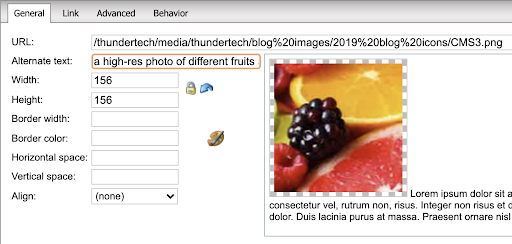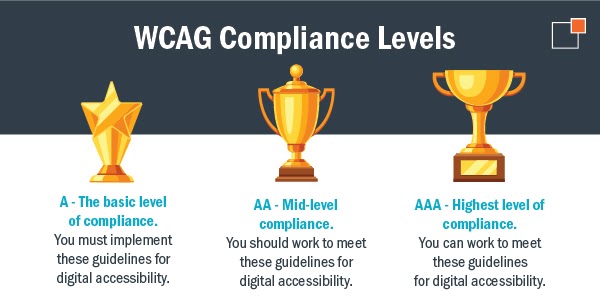A Guide to Digital Accessibility
Understanding the Ins and Outs of Accessible Content
The subject of digital accessibility is woefully overlooked in the marketing sphere. Think back - was it even mentioned in your college courses, marketing conferences or continuing education certifications? Many marketers are prone to overlooking digital accessibility, but the two are inherently intertwined.
Gone are the days of leaving your website’s accessibility to your development team or sliding it under the rug. With a little knowledge you can have some autonomy in the process of making your site available for everyone to use and enjoy. Today we’ll cover why accessibility matters to marketers and answer some foundational questions that can help you better understand how it works.

What is digital accessibility?
Digital accessibility is the practice of ensuring that all persons can use a digital product, such as a website, regardless of individual abilities such as sight, hearing, cognitive, reading level and motor coordination.
If you have a web page about caring for kittens, you have the ability to make it an immersive experience with lots of big photographs that help communicate your love for kittens and how to properly care for them. But if a user is one of the 285 million people worldwide who experiences a visual impairment, they won’t be able to take in that content the same way as you may perceive it. The images become useless to them.
To combat this, it is possible to embed metadata into images and other web page elements to describe non-text content. That way a computer can read a description of the images aloud, giving visually impaired users a chance to visualize the same photo in their mind’s eye. Metadata is just the tip of the digital accessibility iceberg.

Why is digital accessibility important?
Some organizations do have to adhere to accessibility requirements set forth by regulators, industry authorities or other groups mandating a certain level of compliance. But for the majority of sites on the web, accessibility is seen as optional.
Studies estimate that up to 70% of websites have not implemented basic accessibility requirements that would allow users with varying disabilities to use the site as intended. This isn’t just limited to small-time sites, either. We’re talking about the federal government and Fortune 500 companies.
Digital accessibility is important on an ethical level simply because without additional consideration in design and development, some people will be unable to access information, products and services that are available to everyone else. It is important on a legal level because the government does have the ability to enforce accessibility laws under some circumstances (more on that later). And finally, accessibility is important on a marketing level for several reasons:
- Marketers must stick to a self-imposed code of ethics to keep the business world honest, fair and inclusive. Digital accessibility is part of this code of ethics. The world is more inclusive every day. The optics of not being concerned with these ethics can have substantial negative consequences to a brand.
- An inaccessible site means disabled users cannot use your site to make purchases or obtain required information.
What is an example of website accessibility?
The quintessential example of website accessibility is one we’ve already mentioned here: visual impairment. But accessibility isn’t just intended to help one set of people. It covers a broad range of people and abilities and most accessibility features help everyone.
For example, think about a form field. Oftentimes a form field is pre-populated with the information that field is intended for. The “email” field will have greyed out text inside the field that says “email.” Like this:


But once you click into this form field, the greyed out text disappears, replaced by your cursor. There is no text for the computer to read aloud for the visually impaired, but it’s also easy for users with limited cognitive abilities to lose track of what was supposed to go in the form field after the grey placeholder text disappears. The more accessible solution is to place form field labels outside each field. Like this:

Thinking this way also helps elderly site users who are more likely to experience mild issues with visual and cognitive impairment. It’s important to keep users of all abilities in mind every time you post a blog, update a page or build an entirely new site, even if you don’t consider them to be in your immediate metaphorical target audience.
How do you achieve website accessibility?
Accessibility is a multidisciplinary effort because it comes with a set of rules. Actually, it comes with multiple sets of rules, but the de facto accepted main set of rules is called Website Content Accessibility Guidelines (WCAG).
WCAG provides a sort of website checklist for meeting sufficient accessibility guidelines. The rules are divided into three levels: A, AA and AAA. A is the basic tier and the easiest to meet. It’s also the most common standard for site design. As you move up to AA, you take all the rules and checklist items in the A level and add another set of rules. Same with AA to AAA. You never take rules away, just add more.

The AAA is an extremely high standard almost impossible for small time website developers to meet. While it is admirable to shoot for this level of accessibility, meeting A criteria is a perfectly acceptable starting goal that will already put you at a level more accessible than 70% of the sites out there. Starting with the AAA level can leave you overworked, overwhelmed and discouraged. There’s no shame in baby steps to make your site more accessible!
Something else important to note is that accessibility is multidisciplinary. Many marketers choose to hand it off to their development teams, but this can only get you so far. For example, marketers are usually in charge of writing and posting new blog content. If your content team doesn’t know or understand how to include metadata in their imagery, you’ve already fallen out of accessibility compliance. Making your site accessible must be a company-wide initiative everyone is on board with.
Am I required to make my website accessible?
The Americans With Disabilities Act (ADA) was introduced in 1990, long before Americans would be used to handling business and making purchases online. The language of the law was limited to physical spaces, not digital.
However, the Obama administration began a practice of enforcing the ADA (usually for government and education websites) under the legal connection that a site should be ADA compliant the same way a brick and mortar building would. The Trump administration did not pursue this issue, but a Biden-era administration may once again take up the torch.
Despite the lack of federal or universal site accessibility laws, the answer is still technically yes, your company is opening itself up to lawsuits if its site is not accessible to all Americans. In legal terms, WCAG conformance is the general standard for site accessibility.
As the world becomes more inclusive and life moves online, accessibility is only going to become more important, so it’s best to take the initiative now to make changes to your site. Start by making little changes to your current site or consider baking accessibility into a new site redesign this year.
The internet is for everyone, and making your site digitally accessible is not just the legal thing to do, it’s also the ethical thing. By understanding the importance of digital accessibility, marketers can work alongside development teams to make site improvements for the betterment of all.
In need of a skilled development team experienced with site accessibility? Looking to audit your current site to see how it complies with current WCAG standards? Click here to learn more about thunder::tech’s website design and development services.
About the Author
Bruce Williams is the Vice President Development Department at thunder::tech. He charts paths with clients to get the most out of digital technology and design. He prefers Marvel over DC and will always be CLE.
Related Blog & News
Contact us today! No pressure, but we are here to help
Reach out to learn more about how thunder::tech can help your business not only succeed, but accelerate.